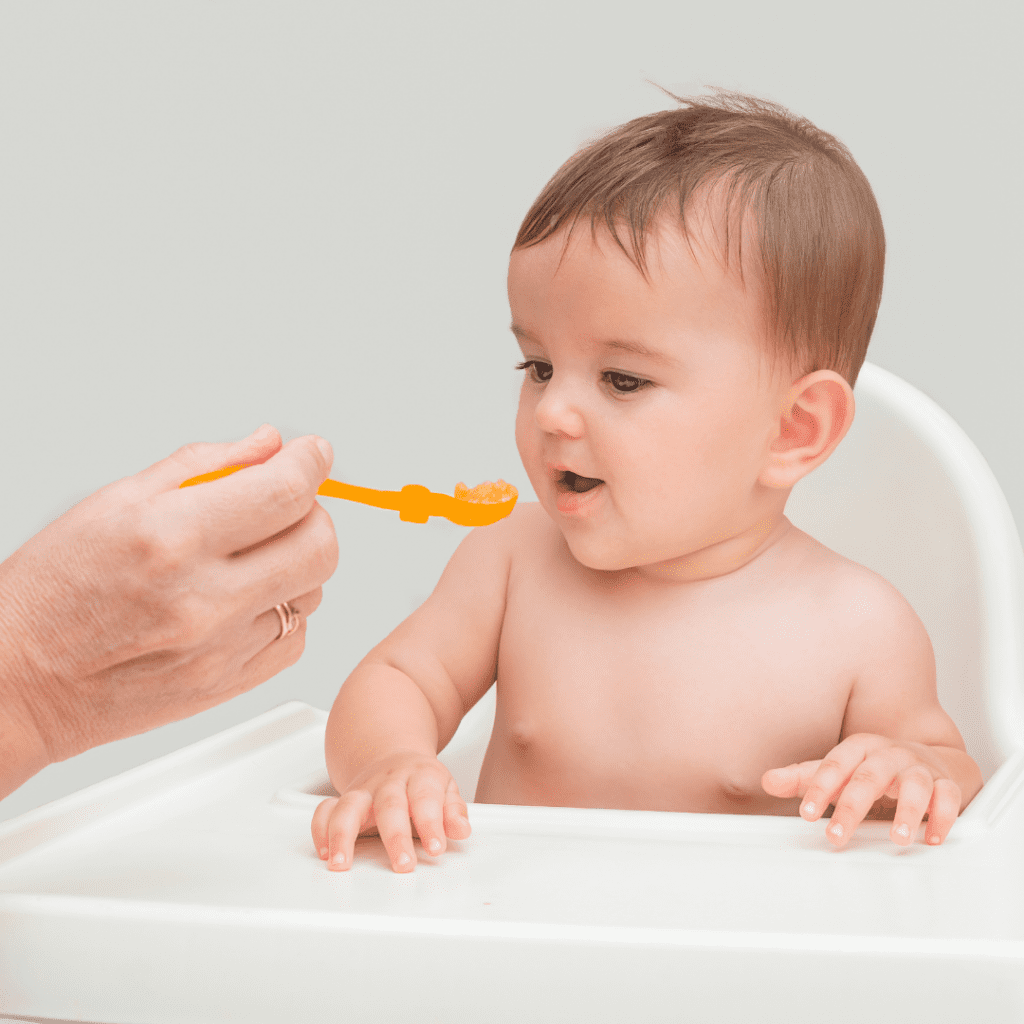If your baby is approaching 6 months of age and/or is showing the developmental signs of readiness to start solids, you’re probably starting to think about how to start and what types of solid foods are best to give your baby.
It can be overwhelming to decide what baby’s first food should be out of all the options out there! Making sure that you’re offering the best option, not only in terms of their nutrition but also in terms of safety, is going to be a top priority.
In this blog post, we’ll share our top recommendations when it comes to baby’s first food – what we think you should start with, how to offer that food safely, and the nutrition to consider. We’ll even go through some of your most frequently asked questions when it comes to baby’s first foods.

If you’d like to know exactly what to feed your baby and save yourself tons of time, you’ll love our 60 Day Baby Led Feeding Meal Plan!
Created by dietitians, it’s designed to walk you through the first 60 days of starting solids with healthy and perfectly balanced meals. Recipes are designed to take into account slow texture progression over the weeks (with spoon-feeding and finger food options for each meal). It also strategically introduces allergenic foods, week over week, so you don’t have to think about how and when to do it all!
Best of all, we include weekly grocery lists, nutrition and feeding tips, and instructions on how to serve the food to your baby. With over 100 new foods introduced in the first 60 days, you’ll feel so confident knowing that your baby is getting the exposure to new foods and textures they need to prevent picky eating – with no extra planning or time wasted for you!
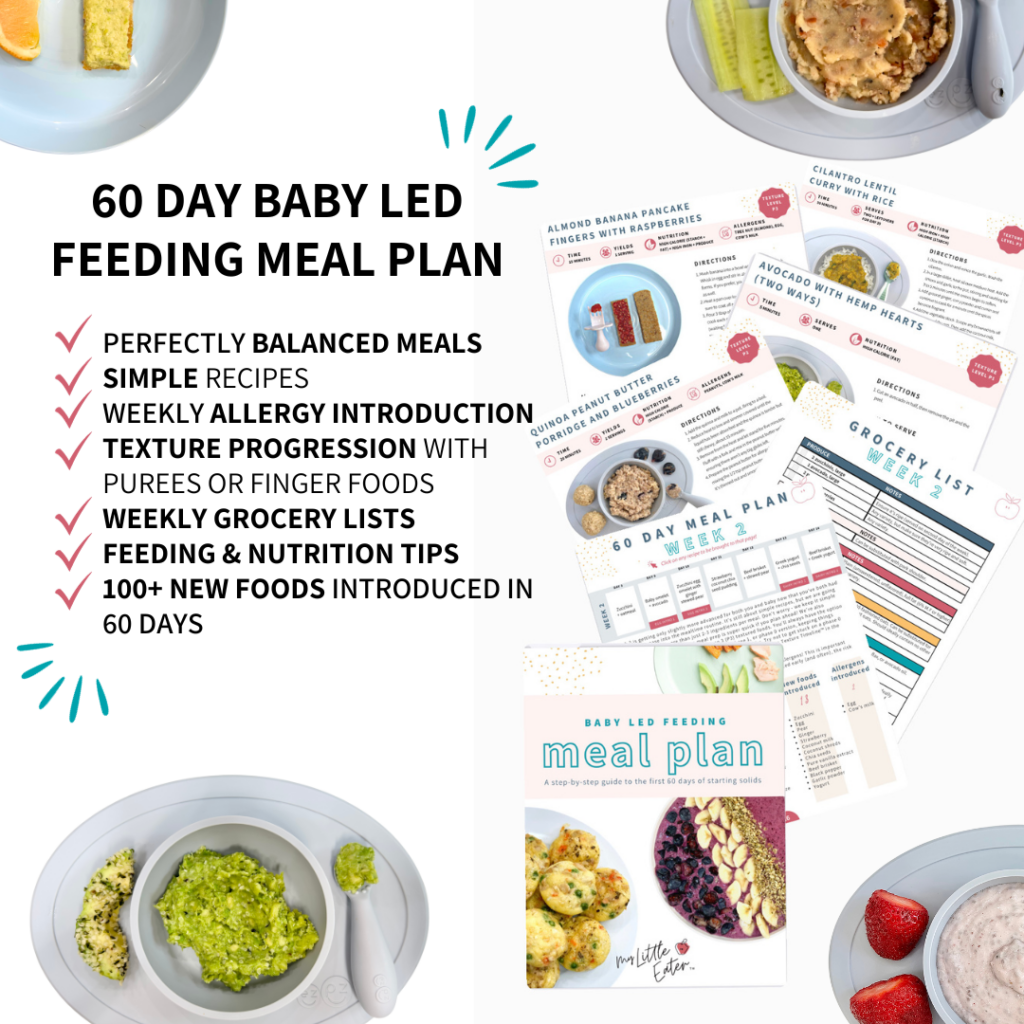
Table of Contents
If you’d prefer to listen to our recommendations for baby’s first food, download the podcast below and listen on-the-go!
What makes a good first food for baby?
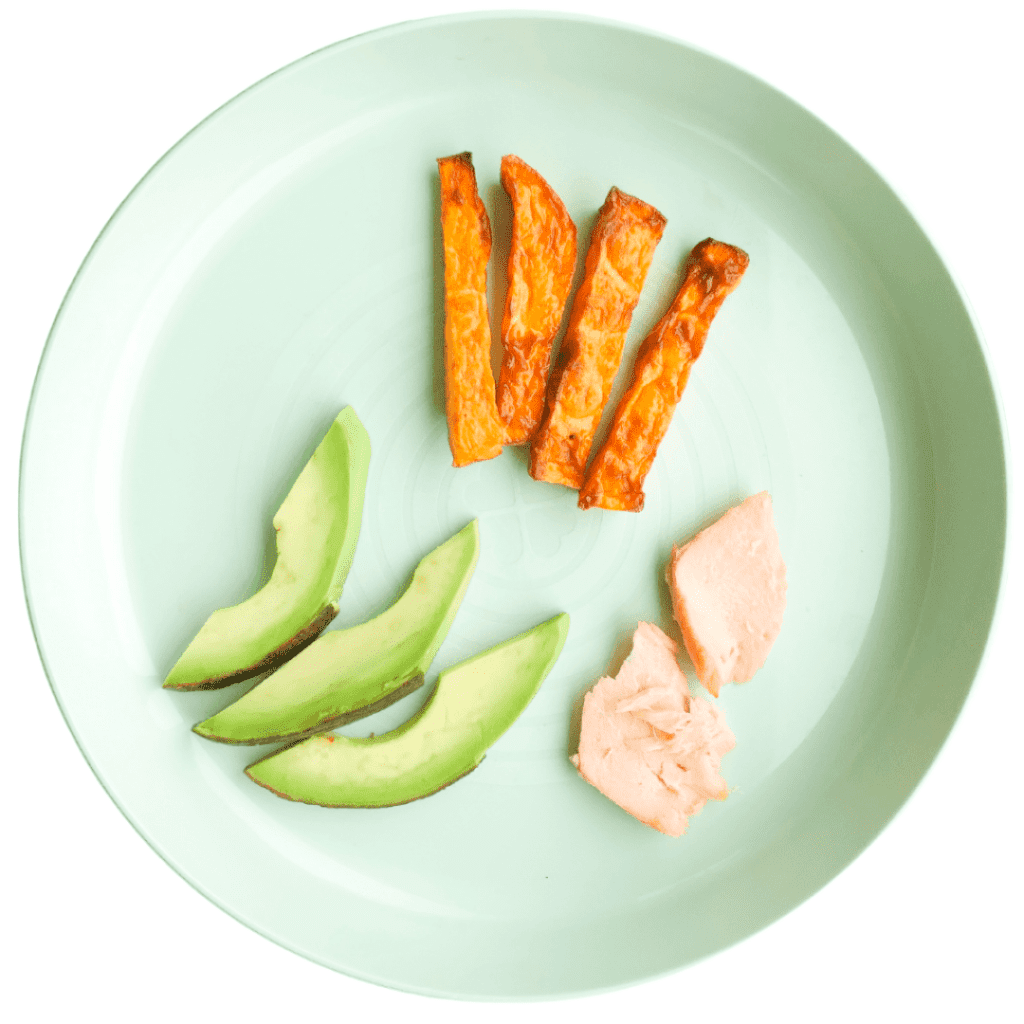
Good first foods are ones that contain a lot of nutrition and are easy and safe for your baby to eat. When you first begin, you can start with single ingredient foods, and move into more balanced meals after the first few weeks.
Ideally, baby meals will consist of foods that are high in iron, high in calories (like a starch or a healthy fat), as well as some type of produce (fruit/vegetable).
We put a lot of emphasis on high-iron foods especially, because babies need a lot of iron for optimal health (more than an adult male!). Therefore, we want to make sure that every meal has at least one high iron food. This will ensure baby is getting lots of practice and opportunities to get this nutrient in.
Most people love to start with sweet potato, banana, and avocado. They’re soft and they’re very easy to prepare. While those foods are great to start with (they even made our top 11 list below!), they aren’t the only foods that your baby should be exposed to for the first little while. The nutrients that fruits and vegetables provide are not nearly enough to cover all of the requirements for babies in the first year of life.
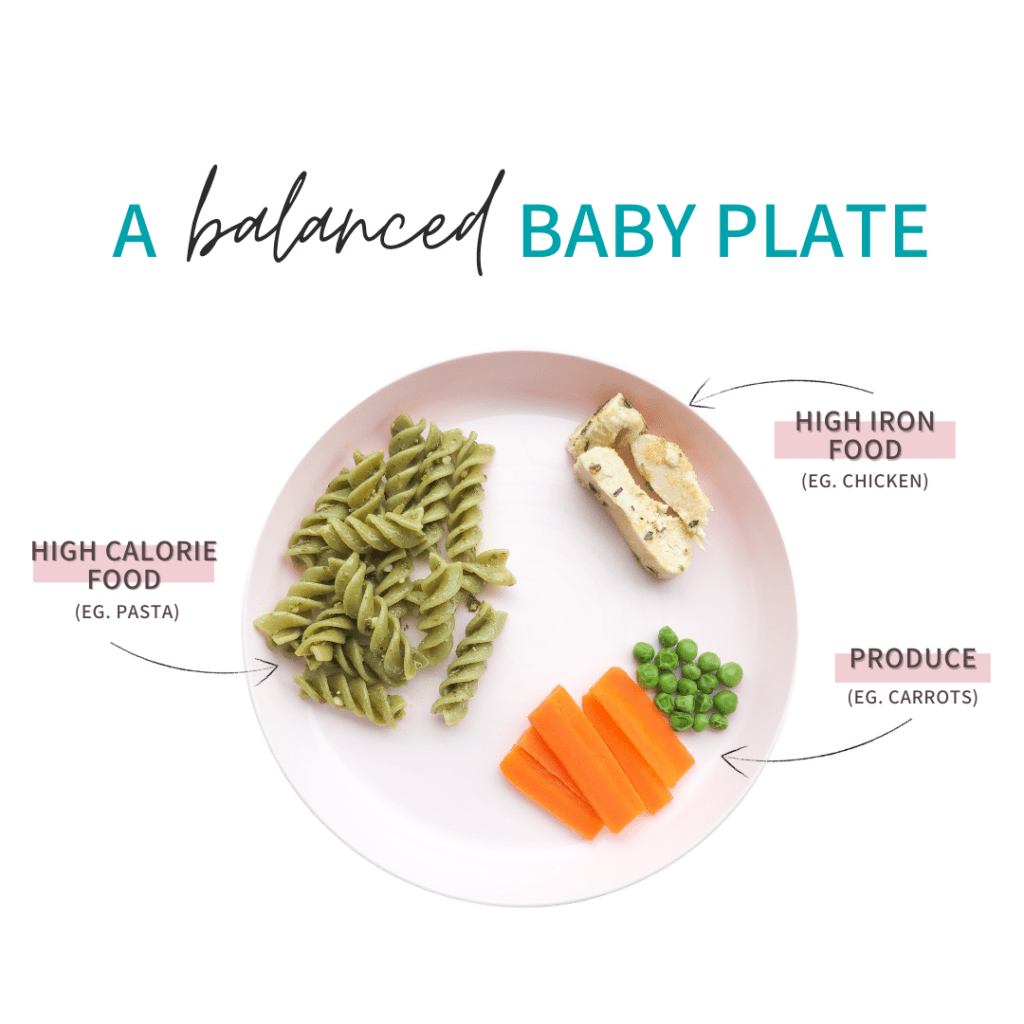
That’s why we believe that variety is the name of the game. There’s no one specific “best” first food. But we’ve put together our list of favorite first foods that we think meet the criteria of being easy to eat, are nutrient-dense, and offer a variety of nutrients when they’re rotated amongst each other.
For more meal ideas, follow along as we share a realistic example of the first week of starting solids.
Best first foods to introduce to babies
Now that you know the basics of how to make a balanced baby plate, let’s look at My Little Eater’s top 11 list of best first foods for babies.
1. Sardines*
High-iron food/high-calorie food
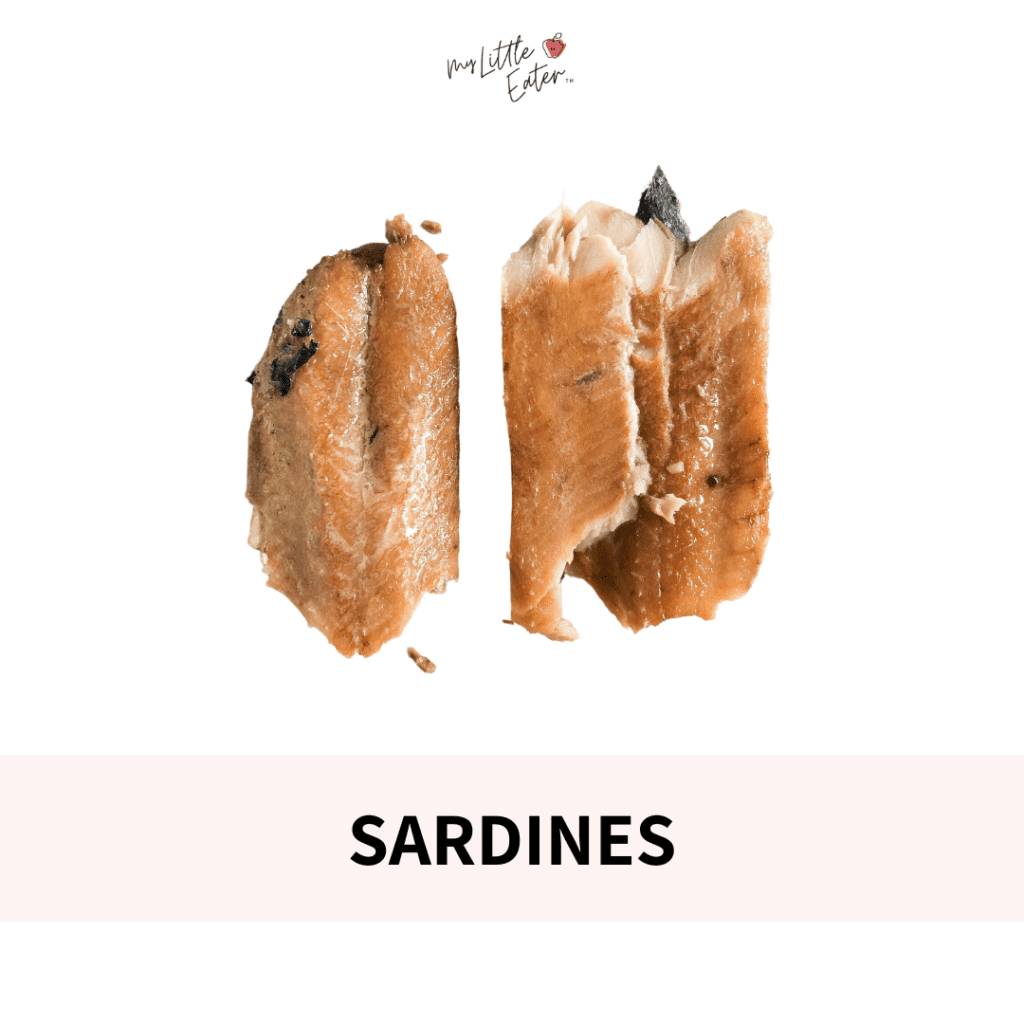
Before you turn your nose up at sardines, hear me out. Sardines are one of the best first foods for babies that you can offer. For one, they’re so easy to prepare. Just open up a can and serve.
Sardines are an excellent source of protein and omega-3s, which are very important for your baby’s brain development…plus…they’re one of the lowest mercury and safest fish to offer to your baby (see our ultimate fish guide for a complete list of the safest and healthiest fish for babies and toddlers).
Sardines are also extremely soft and easy for your baby to chew, and fall within phase 2 of the Texture Timeline™. Despite the smell, most babies LOVE the taste of sardines, and exposing them to the flavor early and often will only help you in the long run because it helps prevent pickiness later on.
See the video below for how to serve sardines based on the texture phase your baby is in (as a puréed baby food or finger food).
2. Eggs*
High-iron/high-calorie food
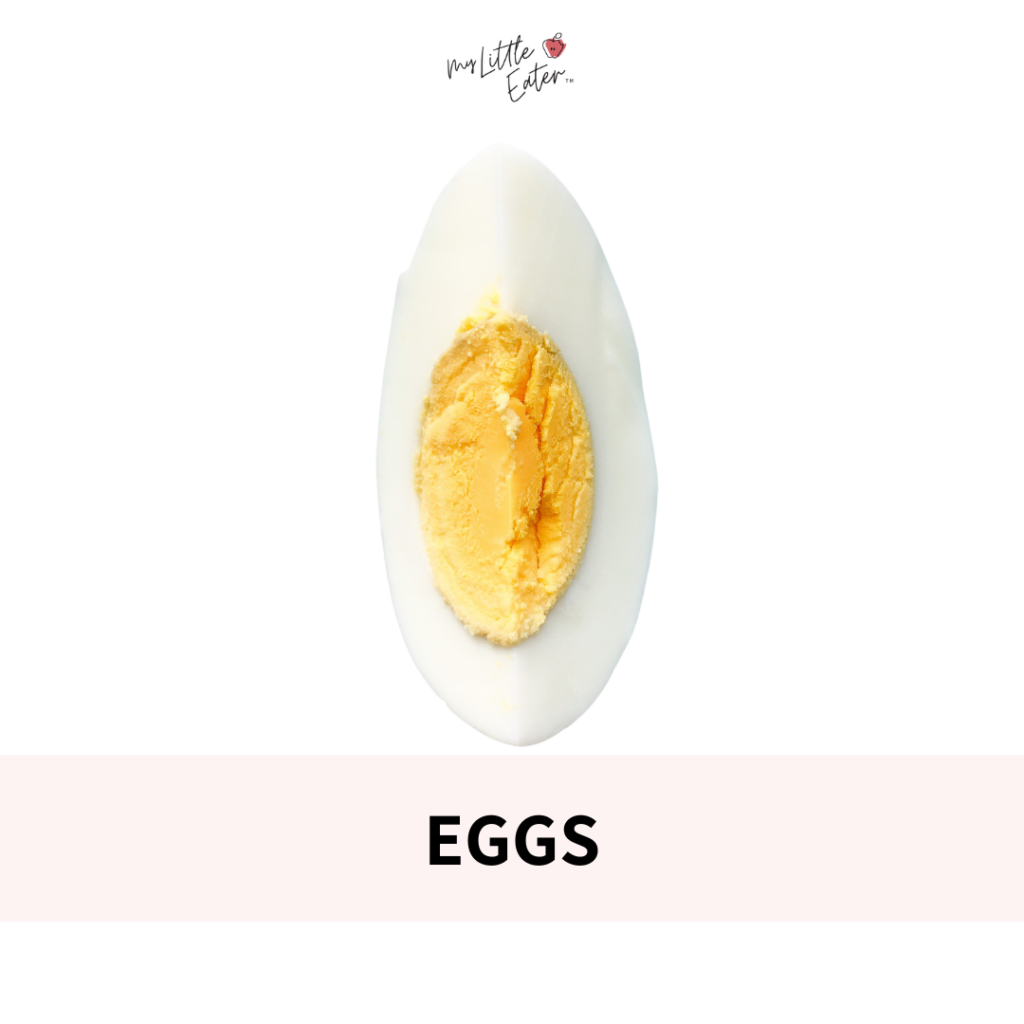
Eggs are one of the top first foods for babies because they are so nutrient-dense. The yolk in particular contains a lot of fat and iron, both of which are very important for your baby’s growth and development.
Eggs can be made into a puréed baby food with a little bit of breast milk or formula, or they can be served in a baby omelet, as a fried egg strip, or thinly sliced hard-boiled egg. Each of these fall on different phases of the Texture Timeline™.
See the video below for how to serve eggs based on the texture phase your baby is in (as a puréed baby food or finger food).
Baby omelets are one of our favorite options for a baby led weaning food because they’re so versatile and easily make a complete meal for you and your baby. A “baby omelet” differs from a traditional omelet in that traditional omelets have cow’s milk or cream mixed into them for extra “fluff”. A baby omelet doesn’t.
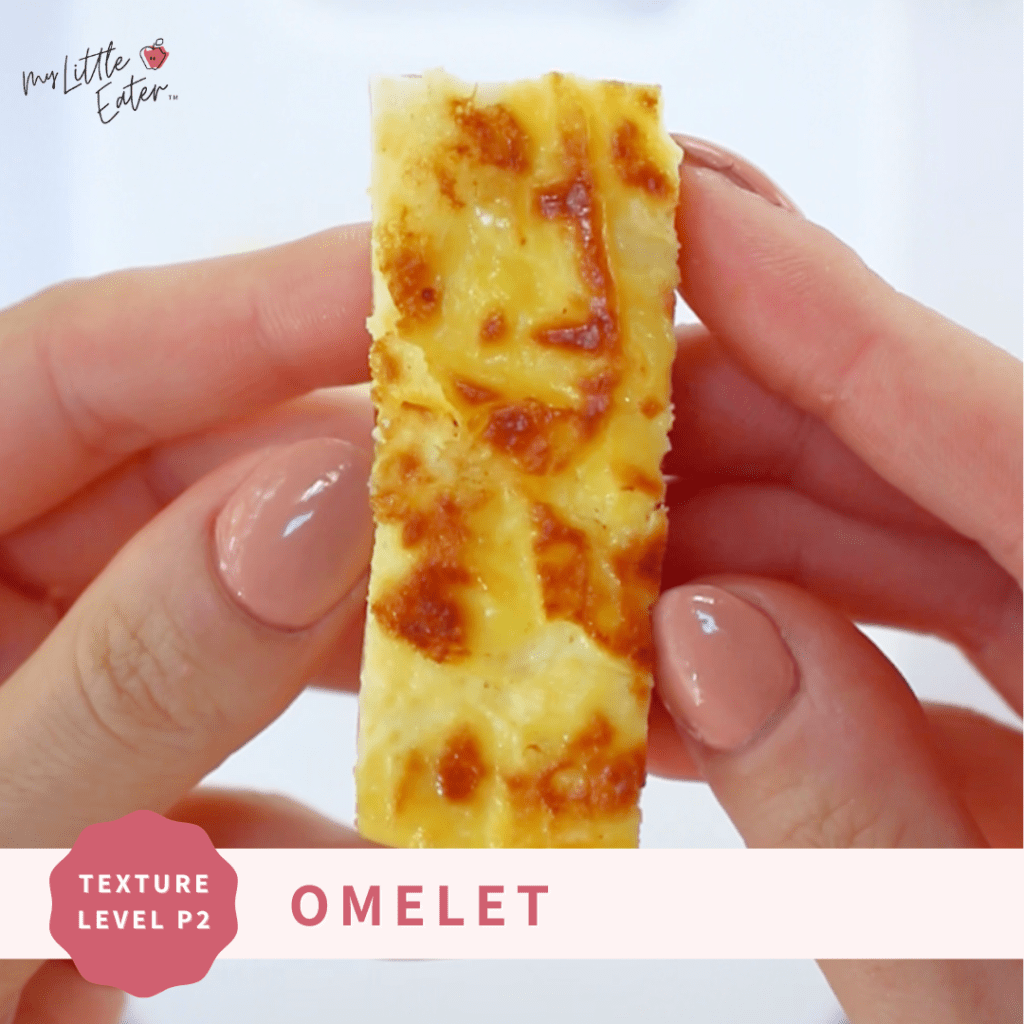
We only want to introduce one allergenic food at a time, and since both eggs and dairy are allergenic foods, a baby omelet recipe involves whisking the egg alone before lightly frying it. You can mix some spices in as well if you like, or add other non-highly allergenic foods (like cooked veggies).
3. Chicken
High-iron food
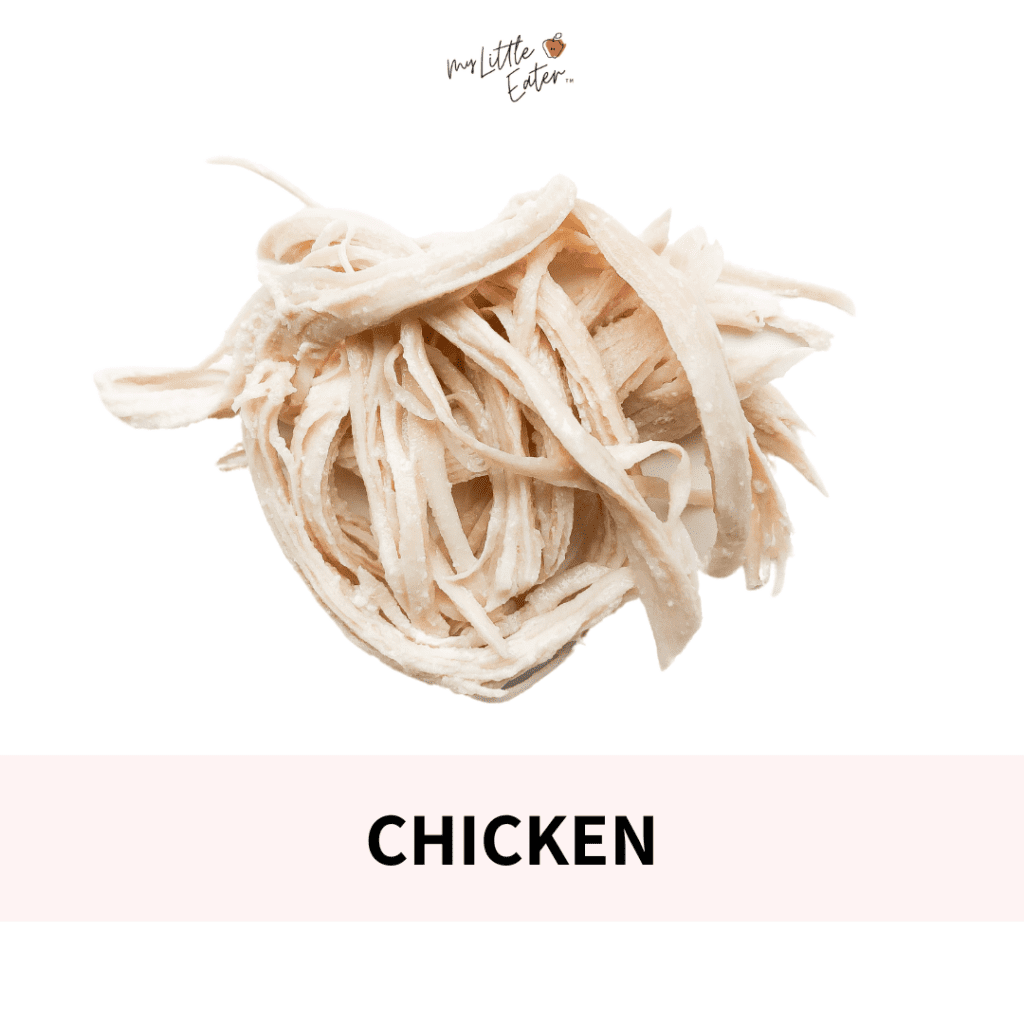
Chicken is another great first food that is going to provide your baby with lots of iron – particularly dark meat, like chicken thighs or drumsticks.
I love getting babies used to the taste of chicken and other meat early on, as well as practicing chewing the complex texture of chicken so that they can learn how to consume it in decent quantities before their natural iron stores are completely depleted.
Chicken can be puréed into baby food or offered as very soft pulled pieces of chicken through cooking methods like a slow cooker, braised chicken, or even baked chicken thighs or drumsticks. Don’t be shy with spices, and make sure to keep the skin on while cooking to keep it extra juicy and moist (remove before serving it to your baby).
See the video below for how to safely serve a chicken drumstick to your baby.
Our 60 Day Baby Led Feeding Meal Plan includes lots of tasty, slow-cooked meat recipes (our favorite method for tender and juicy meat that’s perfect for babies!). It also gives you grocery lists, tips for serving the foods safely for babies, introduces allergens in a timely way, and gradually progresses from easier to more advanced textures. Check it out to make serving baby’s first foods easier and stress-free!
4. Lentils or beans
High-iron food/high-calorie food
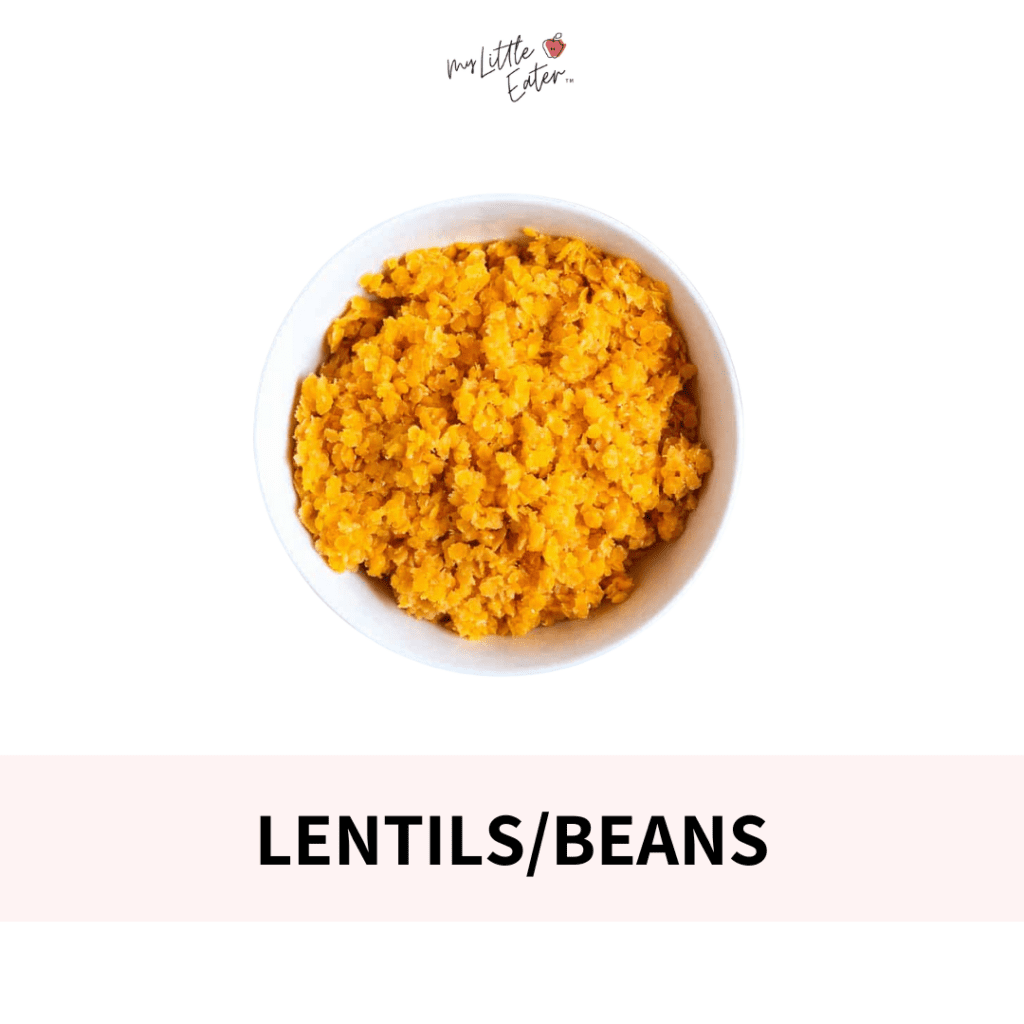
Lentils and beans are amazing non-heme iron sources for your baby. This means that they’re a plant-based source and their iron isn’t as easily absorbed as animal-based sources of iron are. They need to be paired with a source of vitamin C to boost iron absorption and for maximum benefit for your baby. This can be as easy as serving them with a squeeze of lime juice or some tomato purée.
They’re also a great fiber and carbohydrate source. If you notice your baby experiences any digestive discomfort with high amounts of fiber from lentils or beans, start with smaller amounts and work your way up to larger amounts over a couple of weeks.
Since they’re so small and require baby’s pincer grasp to pick up individually (which develops around 9 months), try serving them mashed on top of lightly toasted strips of bread.
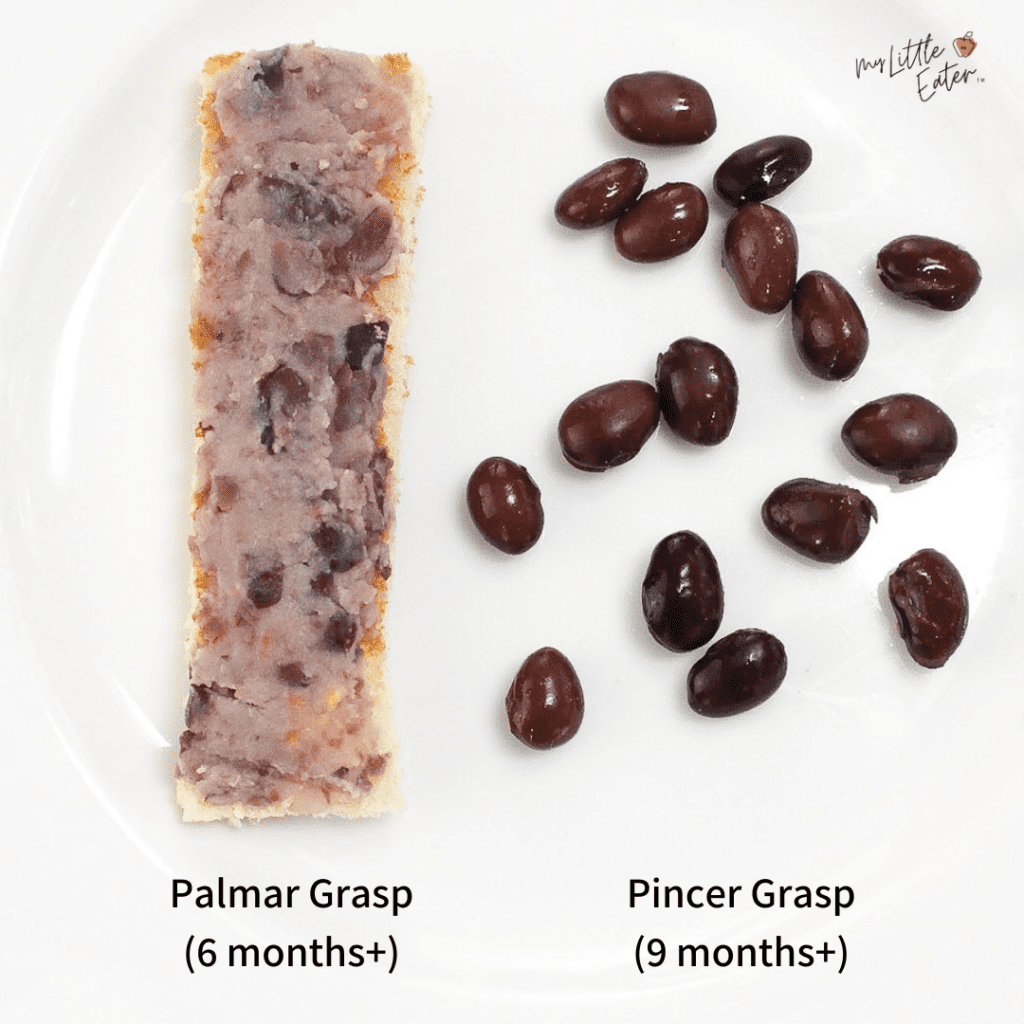
Note: The wheat in bread is considered to be an allergenic food but the beans are not. So go ahead and serve these two together right from the beginning, as you’ll be able to attribute any possible reaction to the wheat itself. You don’t have to serve non-allergenic foods one at a time or wait 3 days between them as was once thought. This is old news! Read more about why you don’t need to follow the 3 day wait rule for non-allergenic foods, here.
5. Avocado
High-calorie food
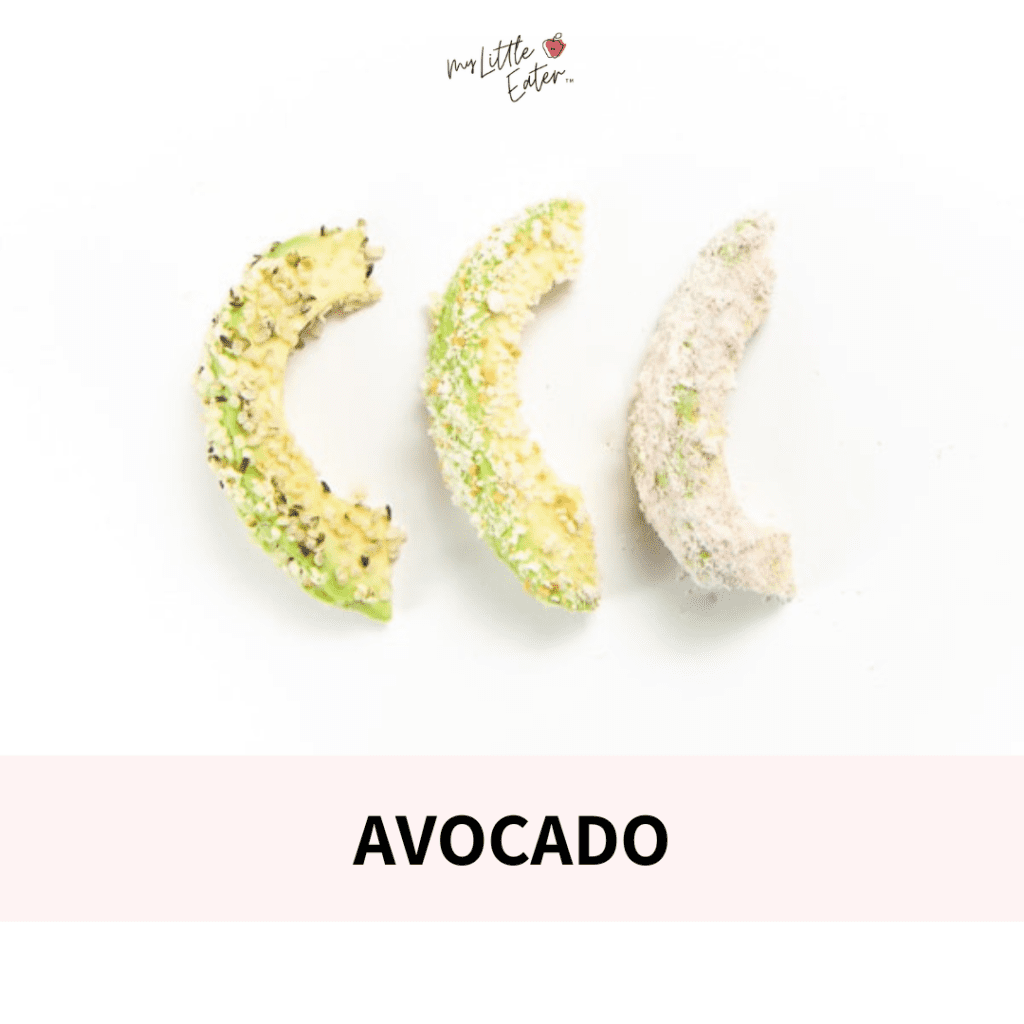
Avocado is of course one of the most common first foods for babies. It’s easy for your baby to mash in their mouth and falls on phase 1 of the Texture Timeline™. This makes it one of the foods that parents feel most comfortable offering first, even with baby’s very new chewing skills.
Avocado is high in healthy fat and is a high-calorie food, both of which are important for your growing baby.
Avocados are very easy to prepare and can be served in a wedge shape, mashed and spread on a piece of toast, or served on a preloaded spoon. You can even leave part of the skin on (be sure to scrub it first if you do) for a better grip for your baby. Or – coat the avocado wedge in something to provide a better grip and an iron boost, like iron-fortified infant cereal.
See the video below for how to serve avocados based on the texture phase your baby is in (as a puréed baby food or finger food).
6. Banana
Produce
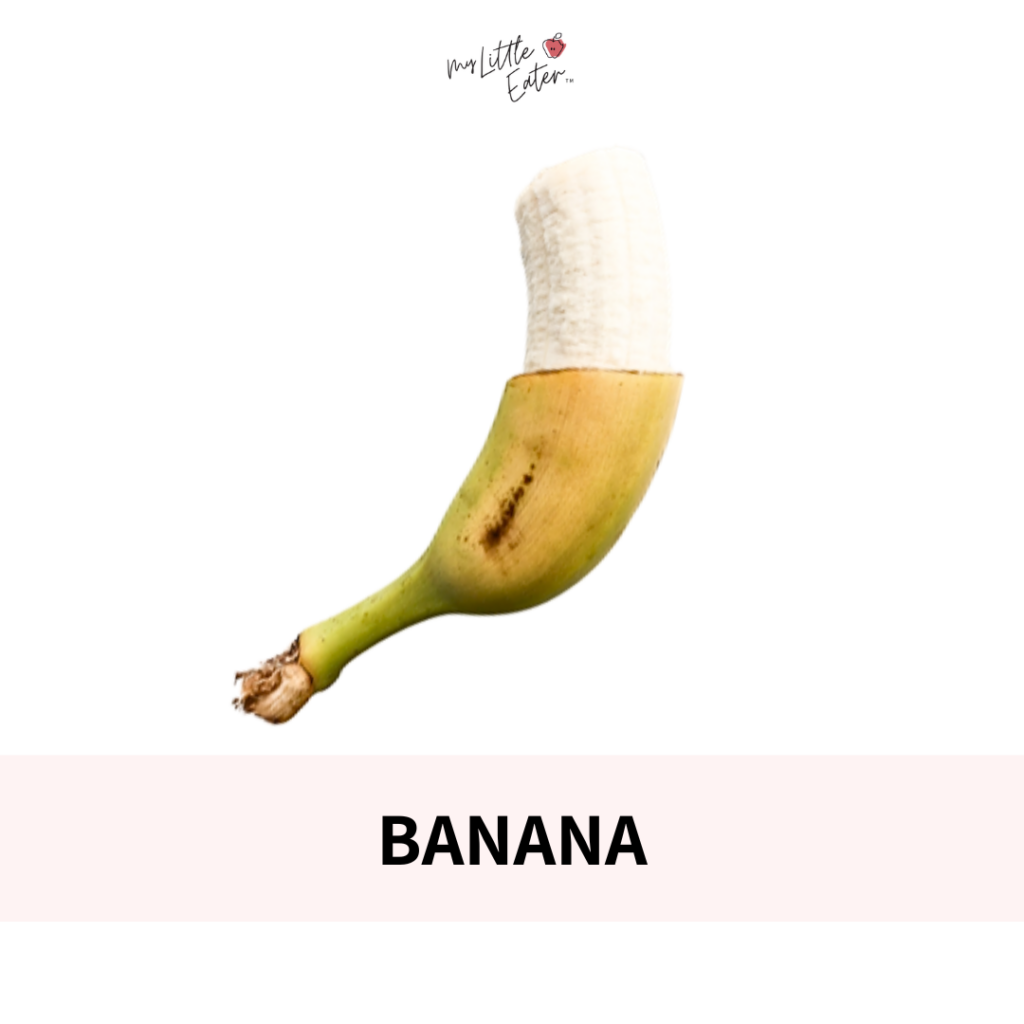
Bananas are also a really easy first food for parents just beginning to ease into solids. Since they need almost no preparation, they’re also perfect for baby led weaning on the go.
Bananas provide a lot of energy via carbohydrates for your baby and can be boosted nutritionally by rolling long finger-shaped pieces in some ground flax seed or wheat germ, or by mixing those into a banana purée.
We recommend ground flax seed because it not only boosts iron but reduces choking risk and increases nutrient absorption compared to whole flax seeds (we can’t digest them whole). Furthermore, coating them in something like this helps your baby grip the banana more easily.
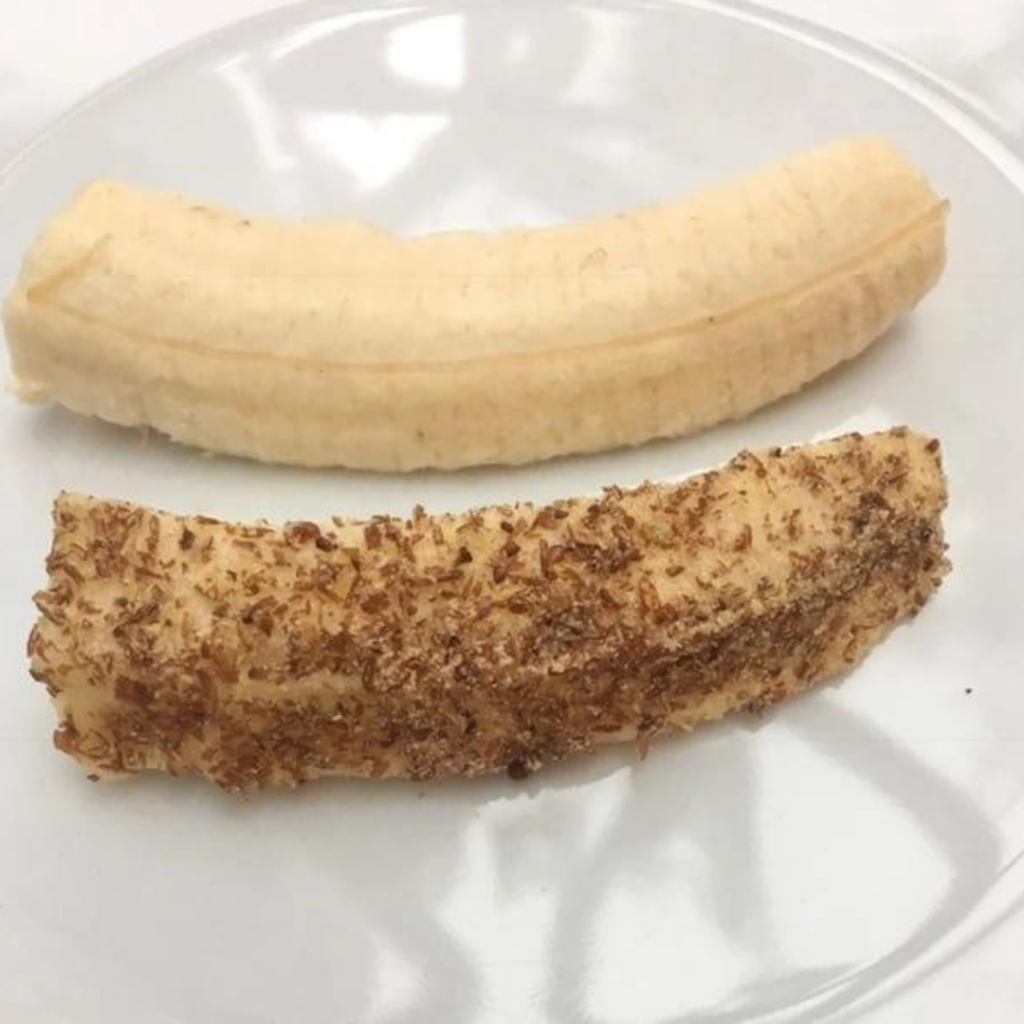
See the video below for how to serve banana based on the texture phase your baby is in (as a purée or finger food).
7. Oats
High-calorie food
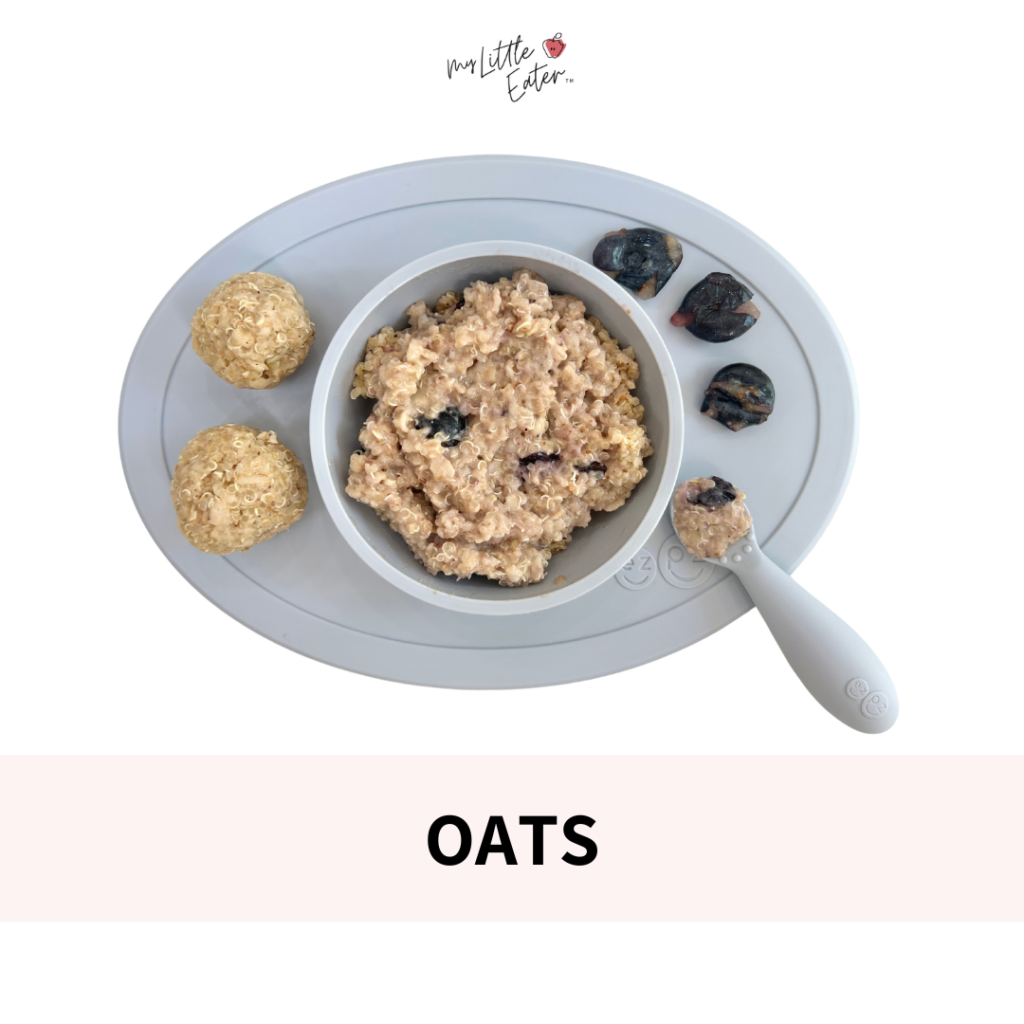
Oats are another great high-calorie food that can be offered in both purée form as a cereal on a spoon, or offered in finger food format by baking into a muffin or in our favorite oatmeal fingers for babies. You can add any mix-in (like unsweetened shredded coconut, hemp seeds, flax seeds, etc) to oats very easily to boost the nutritional content and the flavor as well.
If it’s within your means, purchasing certified organic oats will help reduce the amount of glyphosate that your baby is exposed to.
See the video below for how to serve oats based on the texture phase your baby is in (as a purée or finger food).
8. Beef
High-iron food
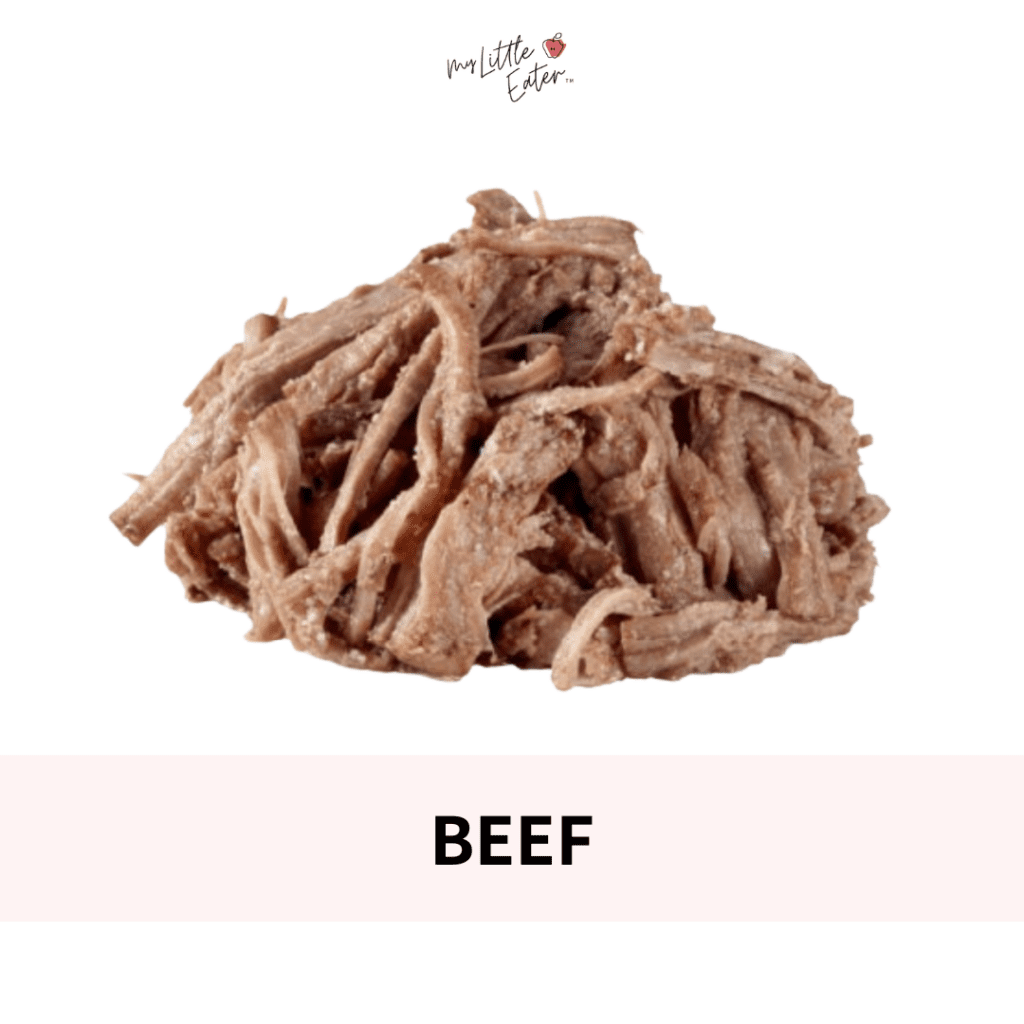
Beef is another powerhouse food to introduce to babies because, again – high iron! It’s really easy to make it soft and juicy for your baby to be able to safely eat, especially if you use a slow cooking method.
Learn more about how to serve meat to babies, and how to serve ground beef specifically. We also have a complete list of the most tender cuts of meat for baby so you have all the info you need when choosing something at the store.
Feel free to add any spices to jazz up the flavor of the beef or offer it on its own.
See the video below for how to serve ground beef based on the texture phase your baby is in (as a purée or finger food).
9. Salmon*
High-calorie food
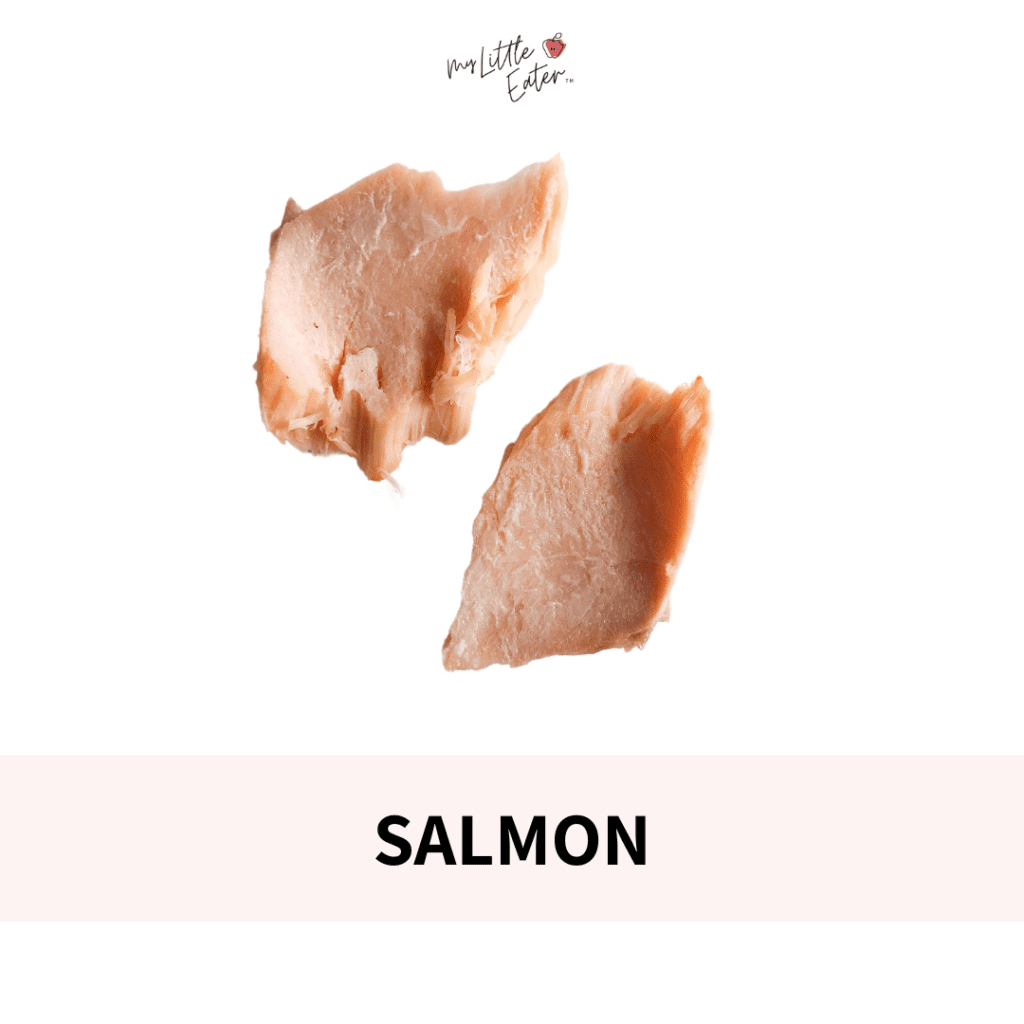
Another fish that’s extremely high in omega-3’s – specifically DHA (a brain-boosting fat very important for kids under age 3) is salmon. It’s also one of the safest fish to give to babies (particularly wild-caught Alaskan!).
Salmon has an oily, soft texture that’s easy for babies to eat (phase 2 of the Texture Timeine™). It’s also simple to prepare and makes for an easy meal the whole family can enjoy.
You can serve salmon in strips or in large pieces broken off of a full piece of cooked salmon for your baby to hold. If your baby continually squishes the salmon in their fist or has a hard time picking it up, you could always throw it into a food processor or blender with a bit of cooked potato, quinoa, or rice, form it into patties, and cook on a pan. The patties should firm up nicely while keeping the soft, easy texture so it’s easier for baby to hold and eat.
10. Sweet potato
High-calorie food
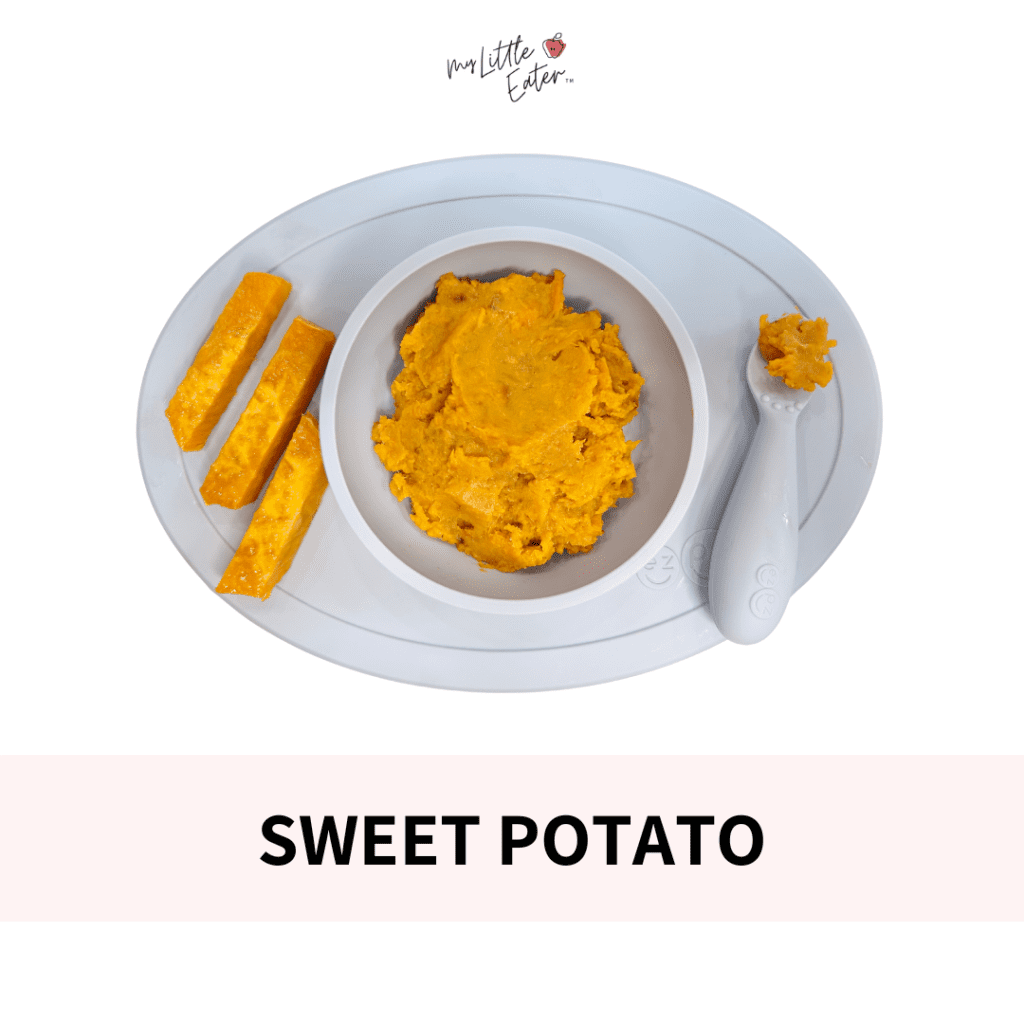
Sweet potatoes are one of the most popular first foods for baby – not sure why sweet potato has become such a staple over other solid foods, but it’s certainly a yummy one!
High in carbohydrates, it provides baby with a quick source of energy, is full of beta-carotene (vitamin A), and is typically well-liked due to its sweeter taste.
Sweet potatoes (along with rice) are a crop that absorbs inorganic arsenic in larger amounts than other vegetables, so while it’s perfectly safe to offer to baby, just be sure to rotate it amongst other foods regularly to minimize excess exposure to arsenic!
See the video below for how to serve sweet potato based on the texture phase your baby is in (as a purée or finger food).
11. Tofu*
High-iron food
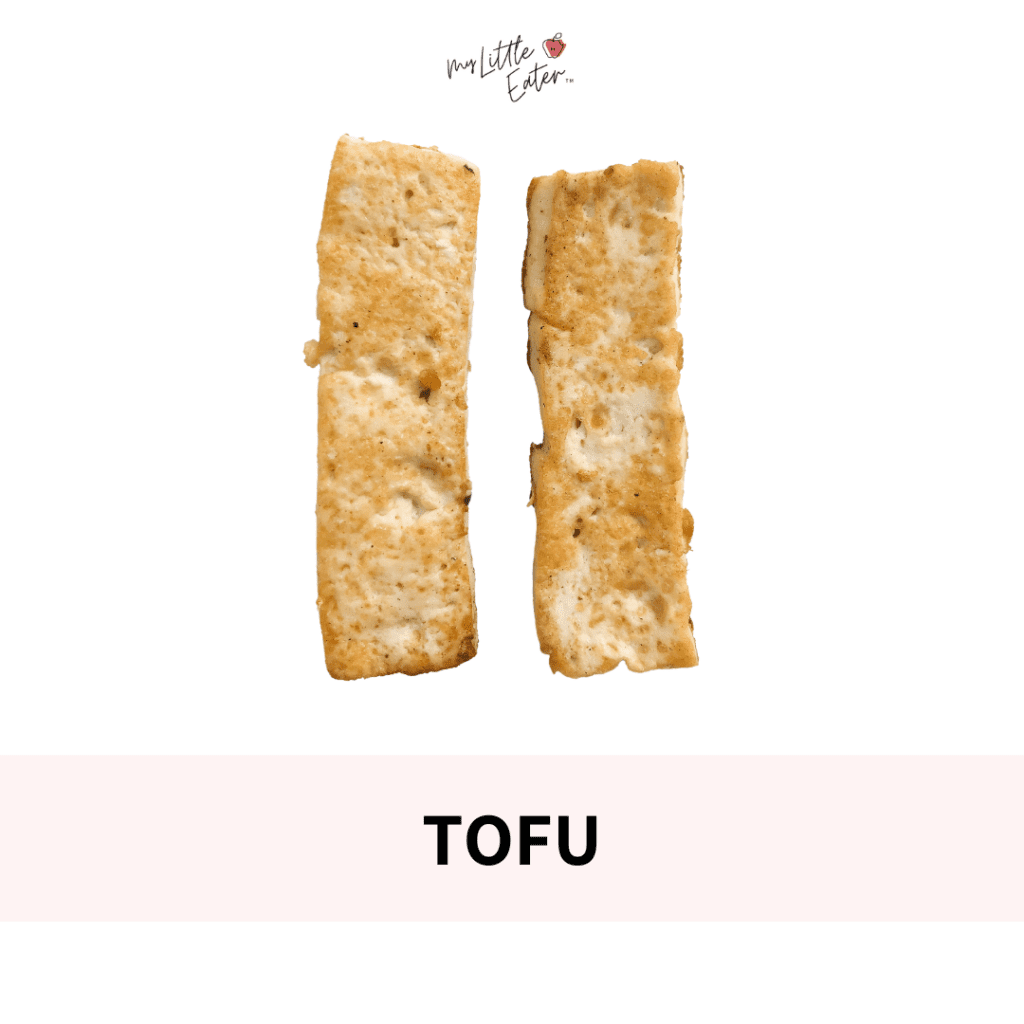
Tofu is a high-iron meat alternative made of soy that comes in a variety of textures, ranging from soft to firm, and basically absorbs any flavor you cook it with. For babies, we recommend either medium or firm textures so that they hold their shape when baby picks them up, yet are soft enough to gum on and melt in your baby’s mouth with very light chewing.
You can simply cut the tofu into strips and pan-fry it on both sides without adding anything to it, however, we recommend including a little flavor to make it more exciting for your baby. Try seasoning the tofu with your favorite spices or herbs.
Tofu is a source of non-heme iron, therefore you can boost the absorption of iron by adding a vitamin C source. Some examples are to add a spritz of lemon or lime juice, or cook the tofu in a tomato-based sauce and serve.
Another seasoning to try is a drizzle of tahini (sesame paste). However, both sesame and the soy in tofu are considered highly allergenic foods. One will need to be ruled out as a food allergy before offering them both together as allergenic foods need to be introduced individually.
See the video below for how to serve tofu based on the texture phase your baby is in (as a purée or finger food).
Note: All foods with an asterisk* are considered to be a top allergen. Follow the allergenic food introduction protocol here.
There you have it! Our suggestions for some great first foods for baby to start with. Serve one of these foods per day if you like and see how comfortable you and your baby are – then, move on to some more challenging textures and get creative!
Now let’s take care of some FAQs about baby’s first foods!
Do babies need to start with infant rice cereal?
No, babies don’t need to start on baby cereal as a first baby food.
Can it be used? Sure!
But do they have to? Absolutely not.
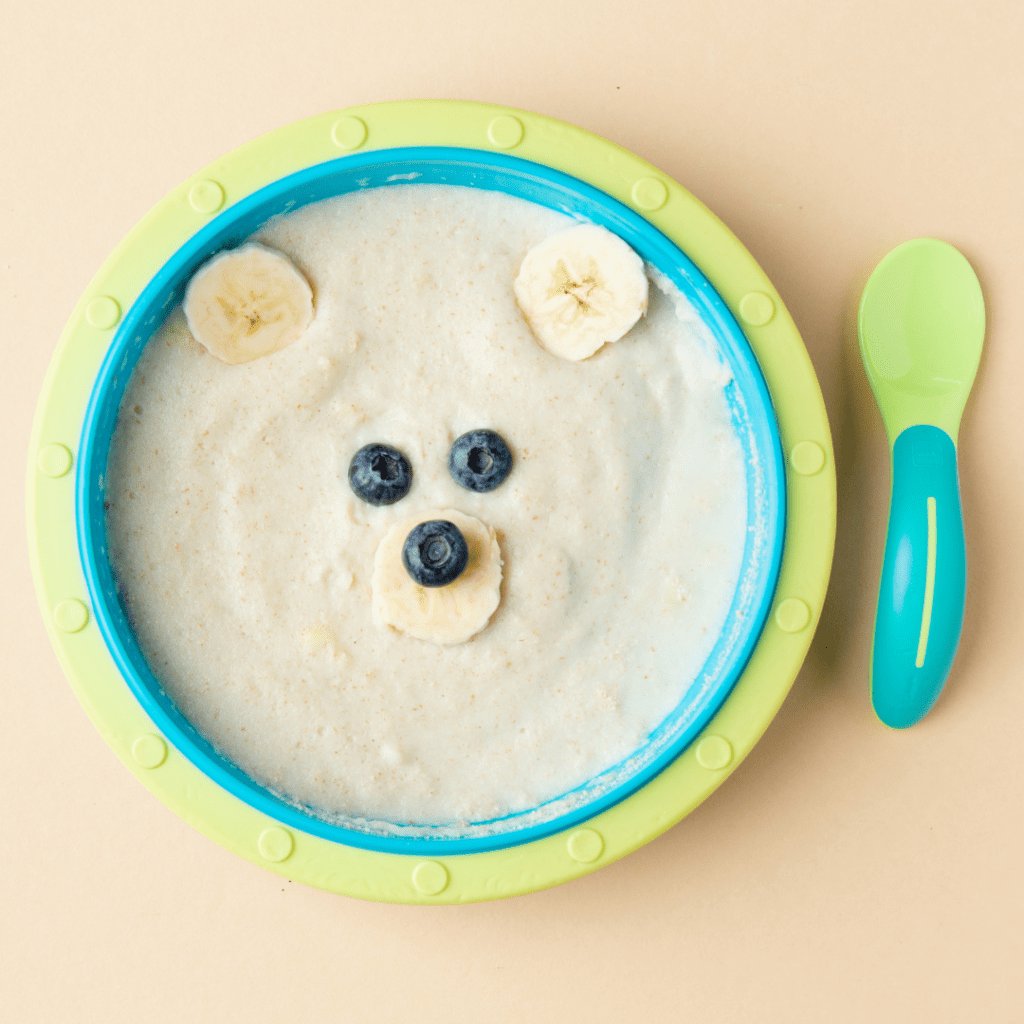
The reason for the common recommendation to offer infant versions of any cereals (rice, oat, mixed grain, etc.) is that they’ve been fortified with iron, which we know is an important nutrient for babies.
But there are so many other high-iron foods outside of just iron-fortified cereals that babies can have. Options that aren’t only going to provide them with the iron that they need, but also will give them that much-needed flavor and texture exposure that’s going to be so incredibly important, especially during the first few months of starting solids.
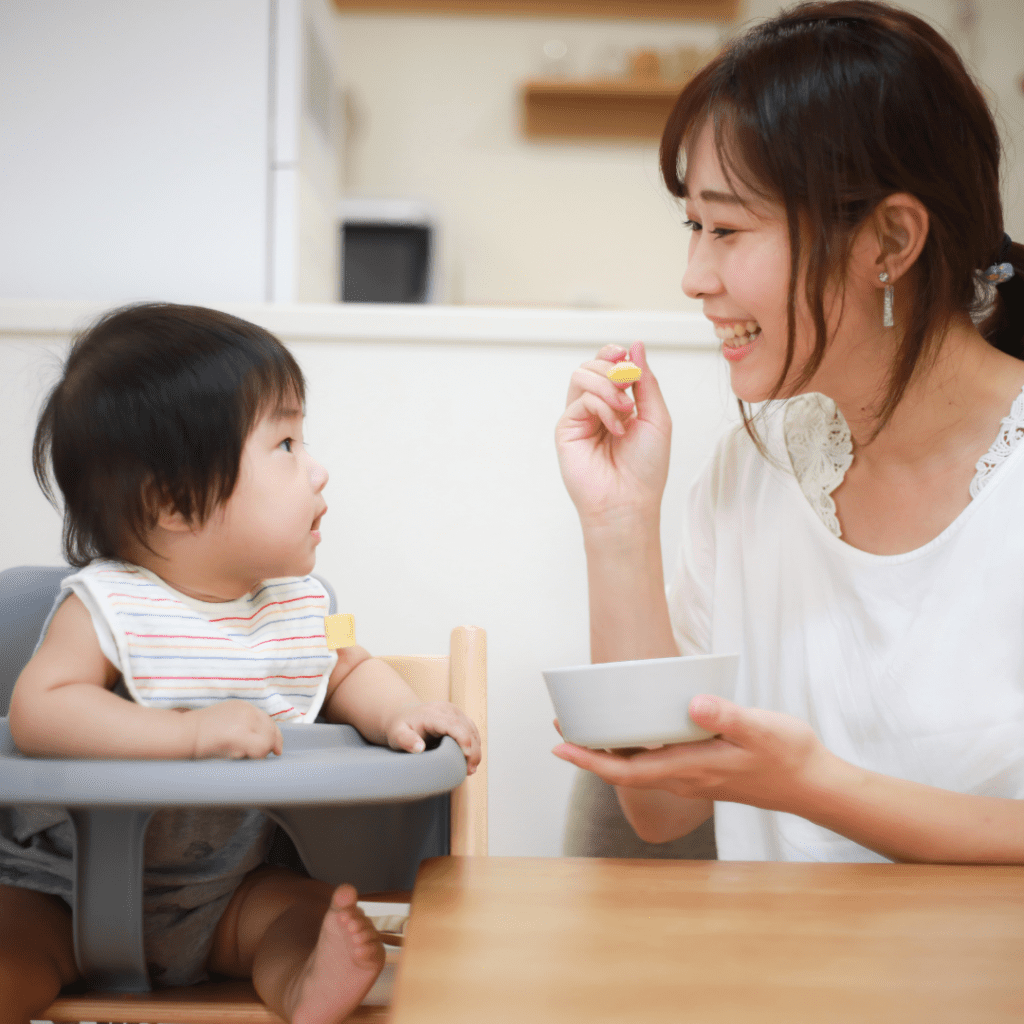
In fact, between 6 and 9 months of age babies need as much exposure to as many different textures and flavors of solid foods as we can possibly give them. That’s because this period of time is known as the “critical window of opportunity” for developing taste and texture preferences.
In other words, the more foods that are offered to baby during this time and the least repetition in their menu…the better their outcome for picky eating prevention and oral motor skill development.
So, while infant-fortified cereal is a great option, it shouldn’t be the only option, nor does it have to be the very first food your baby gets. Focusing on providing a variety of solid foods is going to be much better for them in the long run.
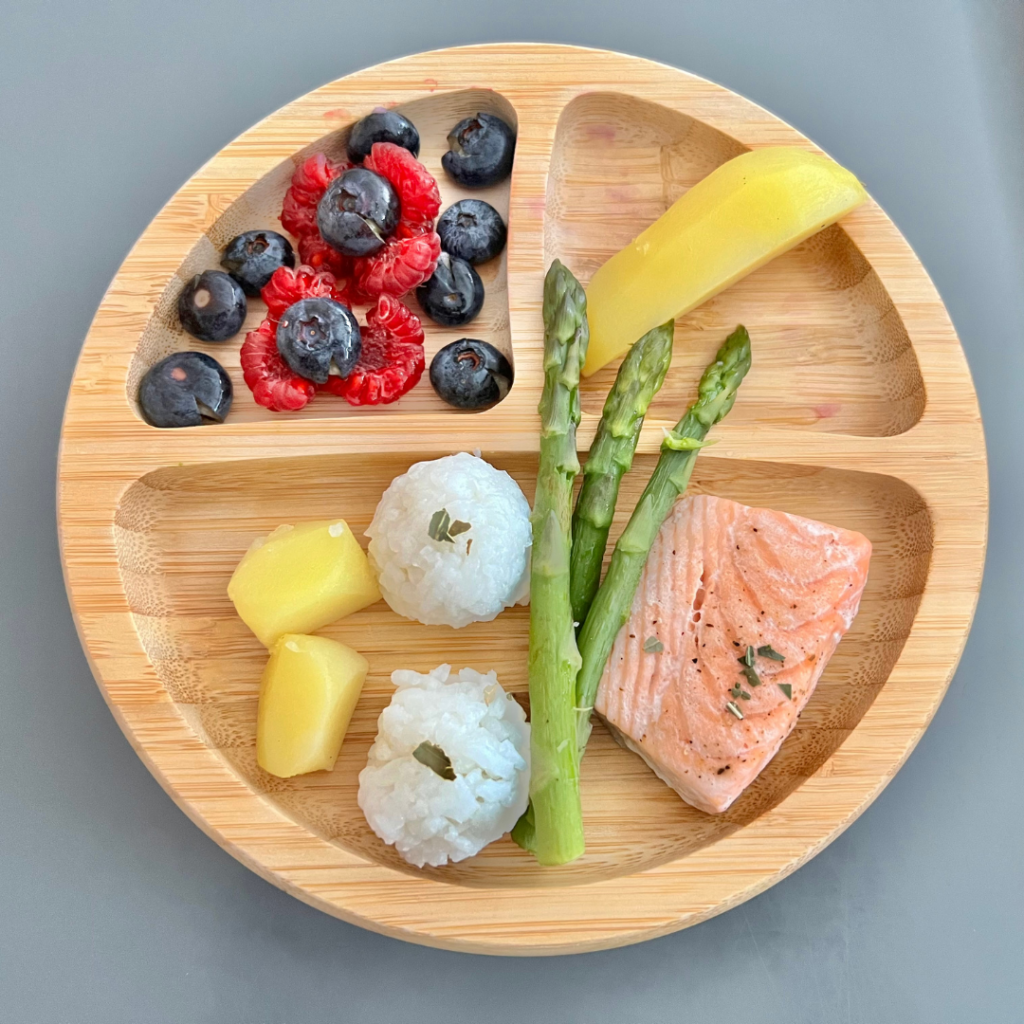
Does baby food have to be bland (or can they have spices and herbs)?
No, baby’s diet does not need to be made up of bland foods, this is an old recommendation that isn’t really based on anything more than an assumption.
Babies can – and should – be offered various spices and herbs right from the beginning. This is one of the easiest ways to add more variety to their solid food and is important for increasing their exposure to various flavors.
Read more about adding spices to baby’s first food, here.
Can a baby try more than one food at a time?
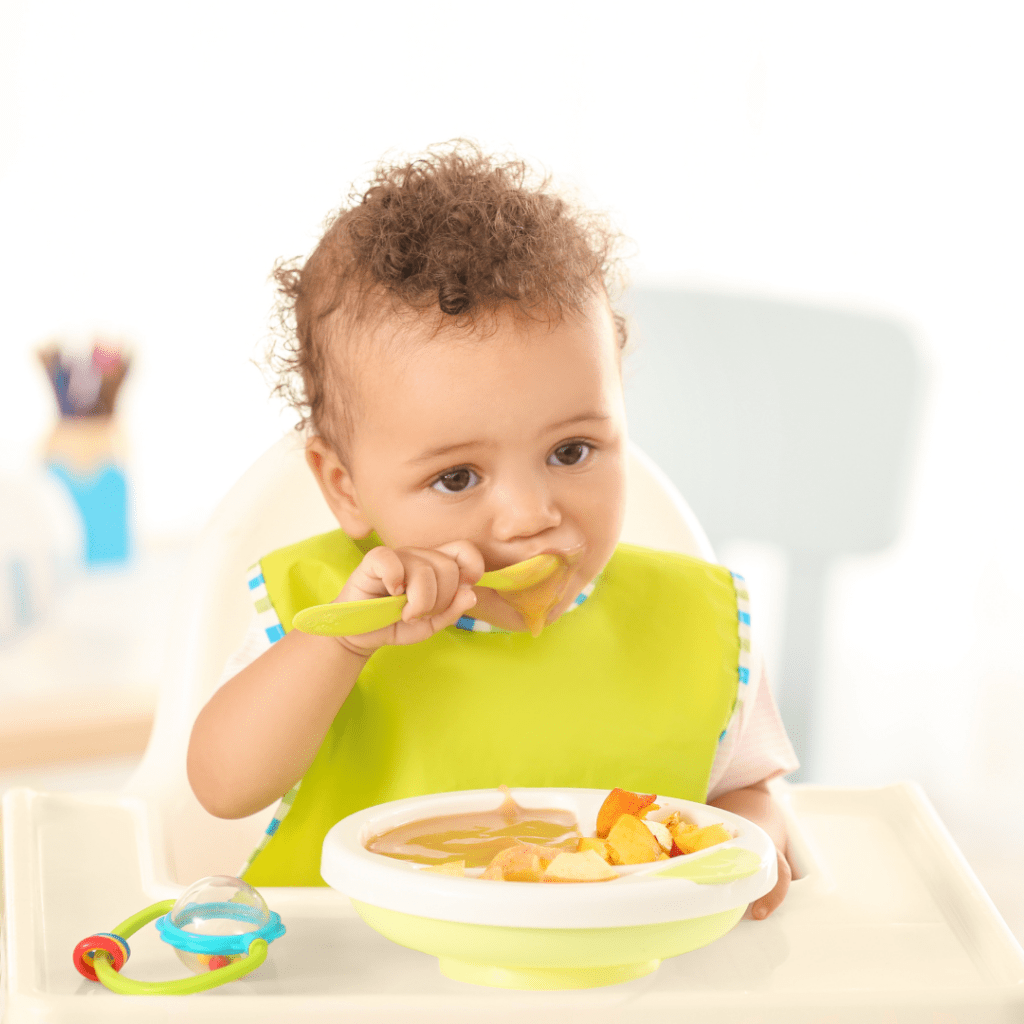
Yes!
There is absolutely no need for babies to have to wait 3 to 5 days between the introduction of new solid foods. This is an old recommendation that is based on no research and was initially told to parents as a way to be able to track any allergic reactions to different foods.
However, now we know with much more certainty that the risk of developing food allergies or reactions to foods that are not on the highly allergenic food list is extremely low. And the repercussions of waiting long periods of time between introducing new solid foods (and preventing baby from experiencing a variety of solid foods in a shorter amount of time) are much worse than the very, very minimal risk of developing a food allergy to – let’s say – chicken.
To learn more about why this “rule” is very outdated and what you should do instead, click here.
Is there a specific order for introducing baby's first solid foods?
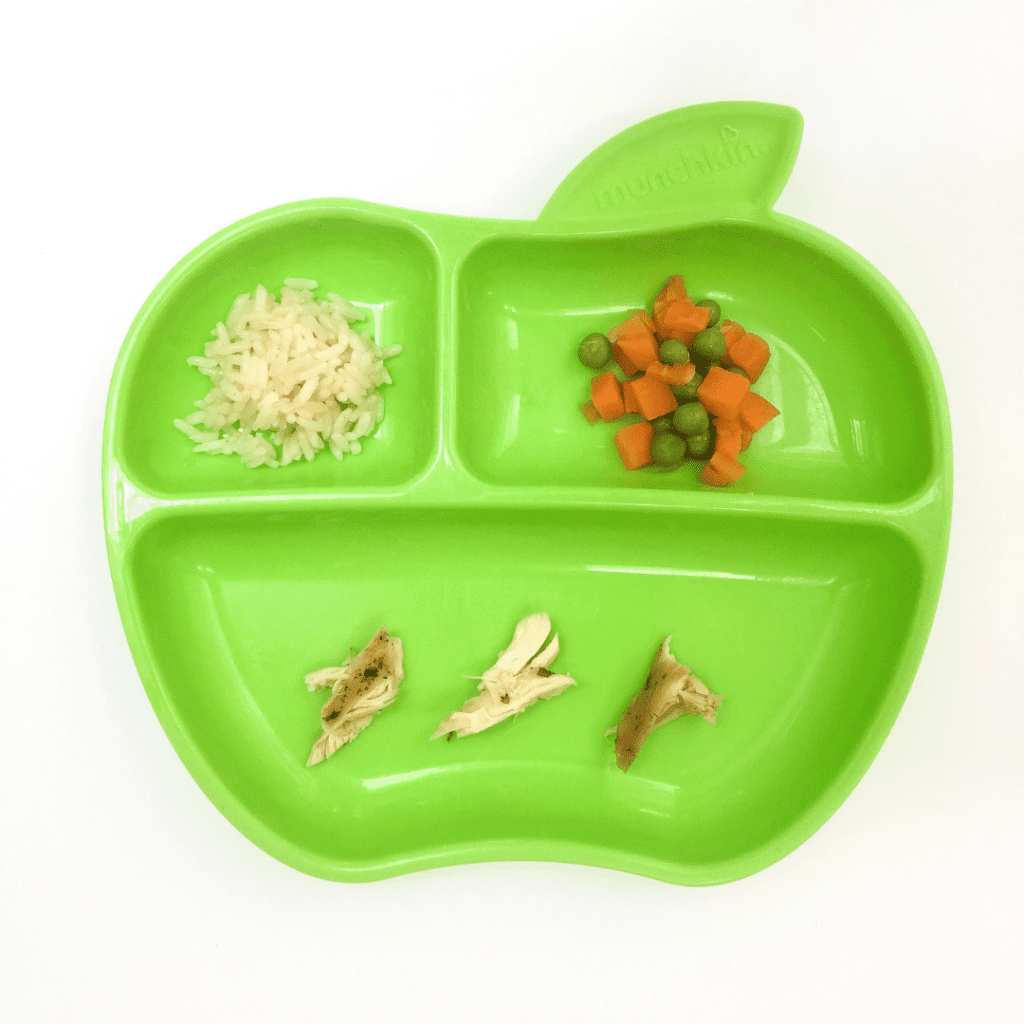
No, there is no specific order that’s required for introducing solid foods to your baby. Many blogs online incorrectly claim that vegetables should be offered before fruit, that meat or grains shouldn’t be offered until a couple of months into starting solids, or that mixed meals need to be introduced after single-ingredient foods.
The truth is, babies have already been tasting a multitude of flavors from breast milk, and if they are being started on solid foods around 6 months of age (and when all developmental signs of readiness to start solids have emerged), your baby’s digestive system is ready and able to handle all types of proteins, fat, fiber, and yes – even gluten.
Concerned about your baby’s ability to digest grains specifically? Read this for the lowdown on how and why babies can digest grains and starches at 6 months of age.
When do you introduce allergenic foods to baby?

It’s now recommended that babies be introduced to highly allergenic foods as close to 6 months of age as possible as research indicates this helps to decrease the risk of developing food allergies.
This doesn’t mean that it has to be done within the first couple of days or the first week of starting solids. But you do want to make sure that you introduce potentially allergenic foods early on in their starting solids journey.
There’s no specific order that determines which allergenic food should be introduced before another. However, you do want to introduce the highly allergenic foods in isolation from other highly allergenic foods. In our 60 day Baby Meal Plan, we do this strategically by introducing allergens that commonly show up in recipes first to rule them out right away.
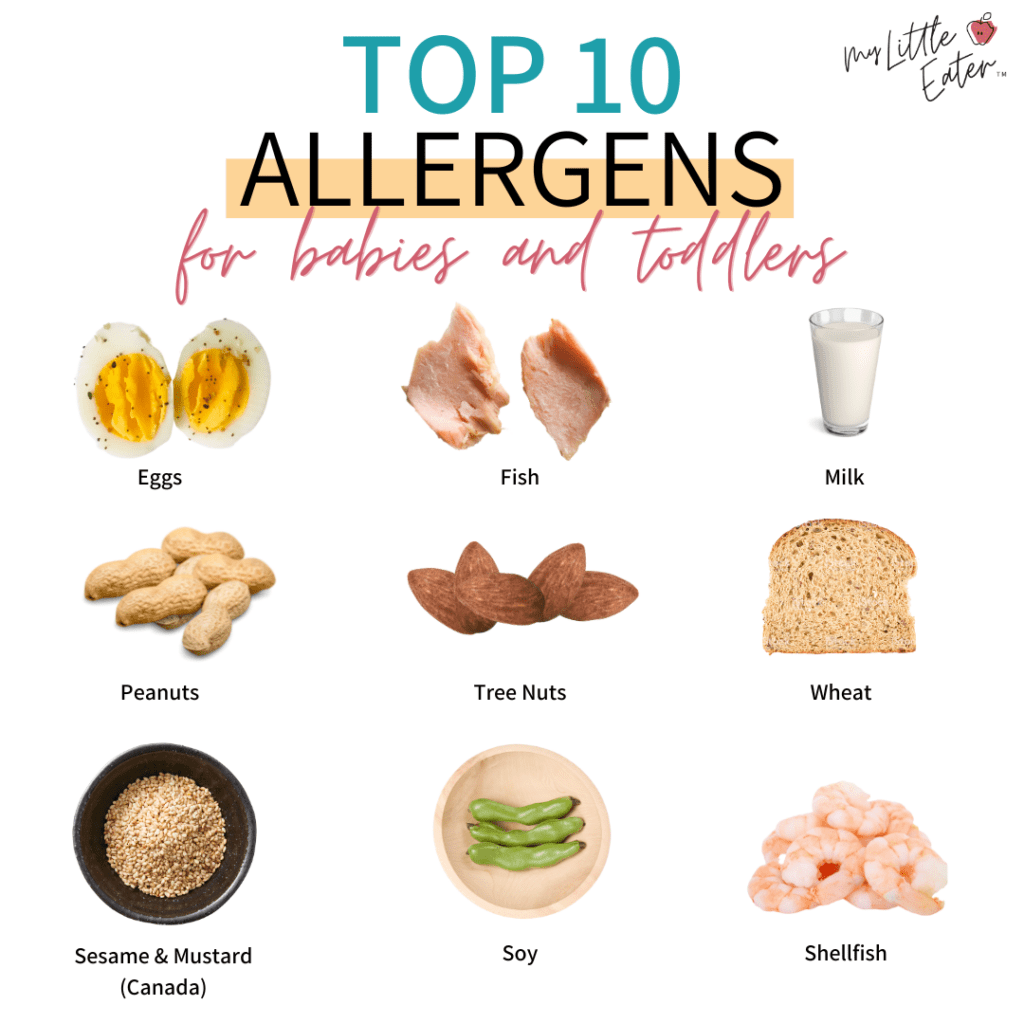
To learn more about introducing highly allergenic foods, what they are, and the recommended protocol for how to do it, click here.
If you’d like to know exactly what to feed your baby and save yourself tons of time, you’ll love our 60 Day Baby Led Feeding Meal Plan!
This meal plan is perfect for parents who want to take the thinking out of starting solids. It provides…
- Day-by-day texture progression (spoon feeding and finger food options for the first few weeks)
- Strategic introduction of allergenic foods
- Weekly grocery lists, nutrition, and feeding tips
- Instructions on how to serve food to your baby
- Over 100 new foods introduced in the first 60 days
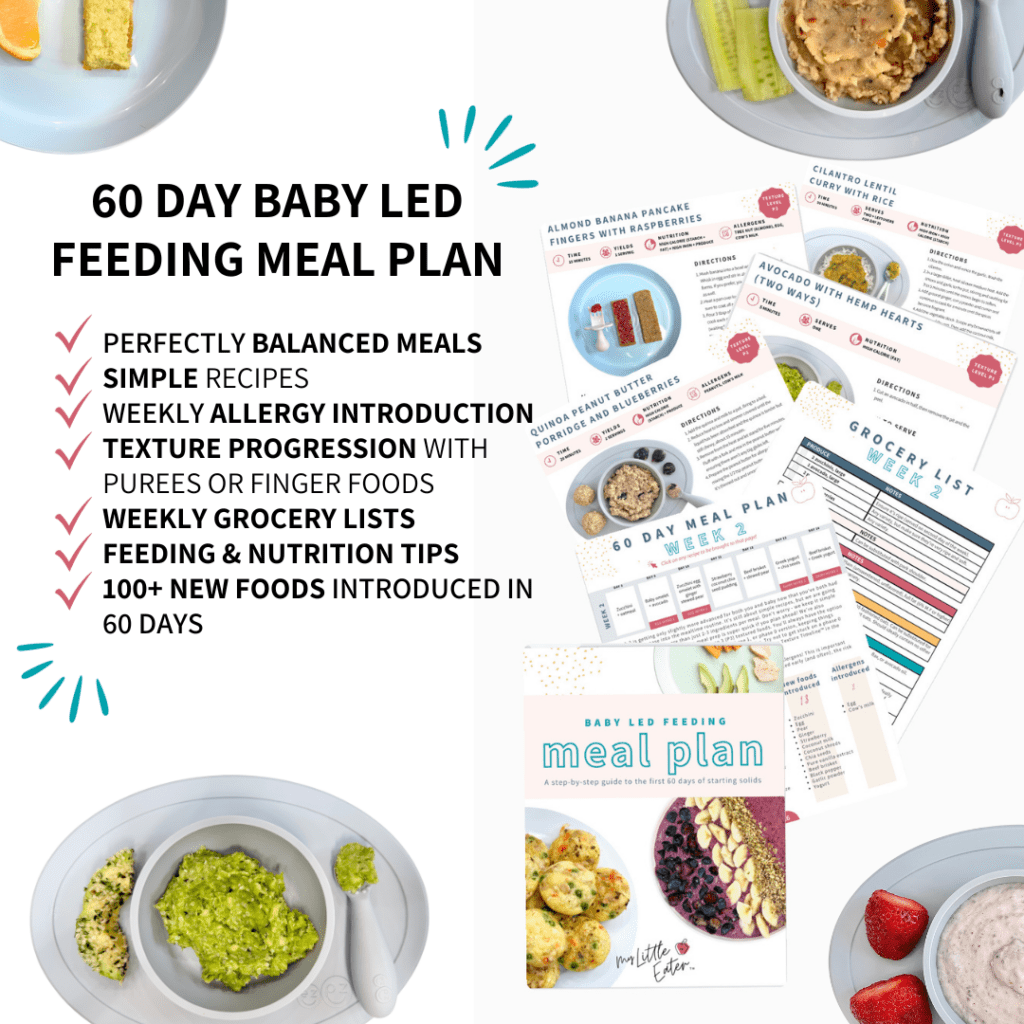
Did you find this helpful? Pin it to save for later!
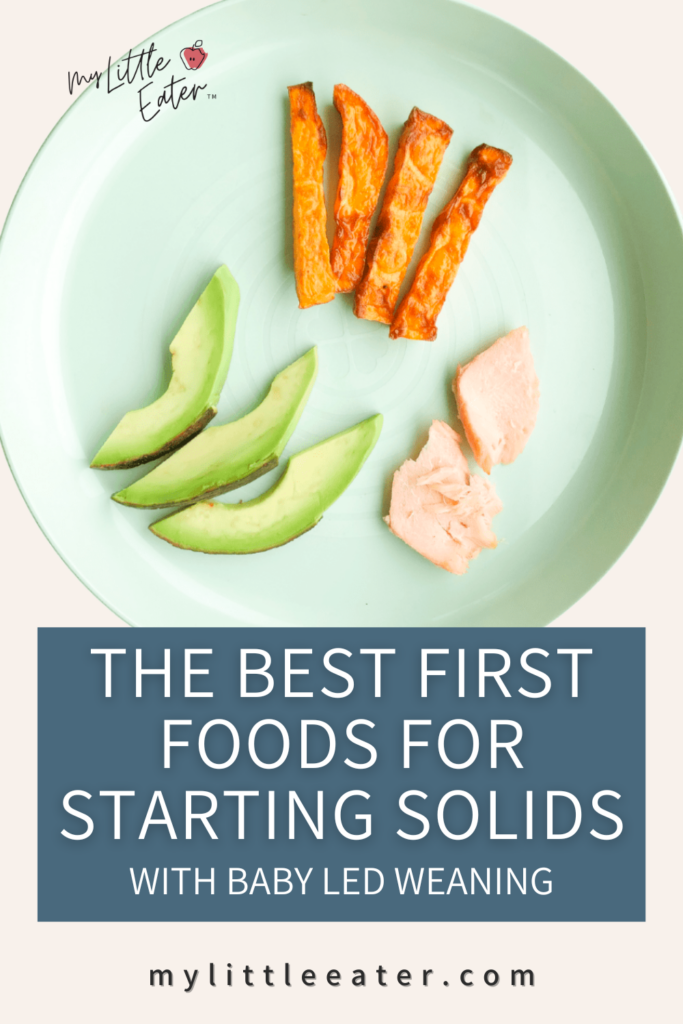

about the author
EDWENA KENNEDY, RD
Founder and lead Registered Pediatric Dietitian at My Little Eater Inc., creator of The Texture Timeline™, and mom of two picky-turned-adventurous eaters.

about the author
EDWENA KENNEDY, RD
Founder and lead Registered Pediatric Dietitian at My Little Eater Inc., creator of The Texture Timeline™, and mom of two picky-turned-adventurous eaters.


